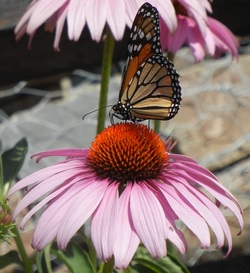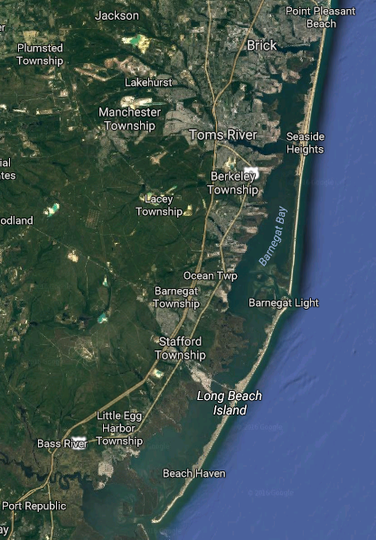|
Barnegat Bay was once a vast food factory brimming with marine life, but numerous factors have adversely impacted its health and productivity, including non-point source pollution due to over-development of its watershed lands. Outdated and inadequate stormwater management has led to polluted runoff which enters and harms the Bay by causing low oxygen content in the water, fishkills, algal blooms, disruption to the food chain, jellyfish proliferation and the reduction or loss of native species.
The Society is working to fix the bay's problems by:
Watch our Barnegat Bay “Clean Water Beautiful Bay” video to learn more about Littoral Society work in Barnegat Bay.
|
Interested in learning more?
Are you:
Are you:
|
A Municipal Official?
Our "Technical Publication" provides details on stormwater improvements that can be implemented in your town. |
A Concerned Clean Water Advocate?
Download a copy of our "Clean Water, Beautiful Bay" brochure on stormwater improvements that you can share with your local officials. |
A Planner or Engineer?
Check out our "Basin Prioritization Matrix" to understand how to target the most crucial areas in a watershed for stormwater improvements. |

BAYSCAPE FOR BARNEGAT BAY
Unlike lawns and high maintenance exotic plants, native plants require little or no fertilizer, pesticides or watering. The Bayscape for Barnegat Bay program shows businesses and private citizens how to create a beautiful, bay-friendly landscape that reduces stormwater pollution, conserves water and creates better habitat for wildlife.
For more information contact [email protected].
Click here to view or download the Littoral Society's Bayscape brochure.
Unlike lawns and high maintenance exotic plants, native plants require little or no fertilizer, pesticides or watering. The Bayscape for Barnegat Bay program shows businesses and private citizens how to create a beautiful, bay-friendly landscape that reduces stormwater pollution, conserves water and creates better habitat for wildlife.
For more information contact [email protected].
Click here to view or download the Littoral Society's Bayscape brochure.

GREEN INFRASTRUCTURE &
STORMWATER BASIN RESTROFITS Barnegat Bay is in serious ecological decline due to overdevelopment of its watershed.
As the Barnegat Bay watershed has developed over the years, much of the land has been disturbed or paved over with concrete, asphalt and other impervious surfaces. Rainwater flows quickly over pavement, lawns and compacted soils, washing pollutants like fertilizer, pet waste and road salt into storm drains that flow to waterways and into Barnegat Bay.
The American Littoral Society has been reducing the amount of pollution entering Barnegat Bay's waterways by implementing "Green Infrastructure" on previously developed sites.
Green Infrastructure promotes water management by restoring or mimicking the natural environment and engineers systems to provide clean water and conserve ecosystem function. One such project installed a green infrastructure project at a local hospital to allow water and its contents to be absorbed into the ground, rather than run straight into a nearby creek.
Additionally, There are over 2700 stormwater basins in the Barnegat Bay watershed and the American Littoral Society retrofits outdated ones to improve the health of the Bay. Stormwater basins need regular maintenance and eventually replacement to ensure they are fully functioning. Most basins, however, end up neglected, and cease to function. This leads to an unsightly area, and a breading ground for mosquitos. A retrofitted basin incorporates native plants which are adapted to the local climate so not only are low maintenance, but also help provide food and habitat for local species of birds and butterflies. For more information about this program contact info@littoralsociety.org.
Click here to view or download the Littoral Society's Green Infrastructure brochure.
STORMWATER BASIN RESTROFITS Barnegat Bay is in serious ecological decline due to overdevelopment of its watershed.
As the Barnegat Bay watershed has developed over the years, much of the land has been disturbed or paved over with concrete, asphalt and other impervious surfaces. Rainwater flows quickly over pavement, lawns and compacted soils, washing pollutants like fertilizer, pet waste and road salt into storm drains that flow to waterways and into Barnegat Bay.
The American Littoral Society has been reducing the amount of pollution entering Barnegat Bay's waterways by implementing "Green Infrastructure" on previously developed sites.
Green Infrastructure promotes water management by restoring or mimicking the natural environment and engineers systems to provide clean water and conserve ecosystem function. One such project installed a green infrastructure project at a local hospital to allow water and its contents to be absorbed into the ground, rather than run straight into a nearby creek.
Additionally, There are over 2700 stormwater basins in the Barnegat Bay watershed and the American Littoral Society retrofits outdated ones to improve the health of the Bay. Stormwater basins need regular maintenance and eventually replacement to ensure they are fully functioning. Most basins, however, end up neglected, and cease to function. This leads to an unsightly area, and a breading ground for mosquitos. A retrofitted basin incorporates native plants which are adapted to the local climate so not only are low maintenance, but also help provide food and habitat for local species of birds and butterflies. For more information about this program contact info@littoralsociety.org.
Click here to view or download the Littoral Society's Green Infrastructure brochure.

BUSINESSES FOR A BETTER BARNEGAT BAY
The health of Barnegat Bay has a direct impact on the strength of the local economy and has long been a key to making the Barnegat Bay watershed a desirable place to live, work, and play. Many businesses have felt the impact of the Bay's declining health and have become involved to help revitalize this icon of the Jersey Shore. The Society launched Businesses for a Better Barnegat Bay to provide a forum to make that happen. If you'd like your business to be apart of fixing what ails Barnegat Bay, please contact [email protected].
The health of Barnegat Bay has a direct impact on the strength of the local economy and has long been a key to making the Barnegat Bay watershed a desirable place to live, work, and play. Many businesses have felt the impact of the Bay's declining health and have become involved to help revitalize this icon of the Jersey Shore. The Society launched Businesses for a Better Barnegat Bay to provide a forum to make that happen. If you'd like your business to be apart of fixing what ails Barnegat Bay, please contact [email protected].

BAY-FRIENDLY GOLF COURSE CERTIFICATION
The Bay Friendly Golf Course certification program provides an opportunity to reduce non-point source pollution entering groundwater, waterways and Barnegat Bay by implementing bay-friendly management practices. The Society's golf certification program assesses a golf course's bay friendliness and makes recommendations for improvements. A golf course may already use many practices that are good for the environment, but may also find that they are good for the bottom line as they reduce operating costs.
Because certification is based on a points system, courses can qualify without implementing all of the changes at once and can work toward higher levels of certification over time with advice from American Littoral Society staff and other certified course managers.
The process can be started by downloading and completing the certification form.
For more information contact [email protected].
The Bay Friendly Golf Course certification program provides an opportunity to reduce non-point source pollution entering groundwater, waterways and Barnegat Bay by implementing bay-friendly management practices. The Society's golf certification program assesses a golf course's bay friendliness and makes recommendations for improvements. A golf course may already use many practices that are good for the environment, but may also find that they are good for the bottom line as they reduce operating costs.
Because certification is based on a points system, courses can qualify without implementing all of the changes at once and can work toward higher levels of certification over time with advice from American Littoral Society staff and other certified course managers.
The process can be started by downloading and completing the certification form.
For more information contact [email protected].

BARNEGAT BAY GUARDIAN
The American Littoral Society introduced the Barnegat Bay Guardian on Earth Day 2011 to strengthen our already robust efforts to protect and preserve Barnegat Bay. Al Wutkowski, a lifelong resident of Point Pleasant, puts his eyes, ears, voice, and boat to work for the Society and the Bay. The Barnegat Bay Guardian has quickly become recognized out on the Bay as the premier Bay Boater volunteer program. If you and your boat would like to join the program please contact [email protected].
The American Littoral Society introduced the Barnegat Bay Guardian on Earth Day 2011 to strengthen our already robust efforts to protect and preserve Barnegat Bay. Al Wutkowski, a lifelong resident of Point Pleasant, puts his eyes, ears, voice, and boat to work for the Society and the Bay. The Barnegat Bay Guardian has quickly become recognized out on the Bay as the premier Bay Boater volunteer program. If you and your boat would like to join the program please contact [email protected].

SHUCK IT, DON'T CHUCK IT OYSTER SHELL RECYCLING
Oysters extract lime from the water so they can grow their shell. This is why the Society recycles oyster shell from local restaurants. The shell is returned to the water where it provides a substrate for new oysters. The Shuck It Don't Chuck It Oyster Shell Recycling Program is a win-win for oyster lovers, businesses and the bay's waters One oyster can clean up to 50 gallons of water per day. Oyster shell from restaurants ordinarily end up in landfills. Our program returns them to New Jersey's bays where they create a foundation for growing new oysters.
Oyster reefs also provide homes for other marine life and protect sensitive shorelines. Historically, they populated our coastal waters, but pollution, disease and overharvesting have destroyed these essential creatures of the marine ecosystem. Our program returns the shells to the bays for cleaner water, a healthier environment and more oysters on our plates.
Oysters extract lime from the water so they can grow their shell. This is why the Society recycles oyster shell from local restaurants. The shell is returned to the water where it provides a substrate for new oysters. The Shuck It Don't Chuck It Oyster Shell Recycling Program is a win-win for oyster lovers, businesses and the bay's waters One oyster can clean up to 50 gallons of water per day. Oyster shell from restaurants ordinarily end up in landfills. Our program returns them to New Jersey's bays where they create a foundation for growing new oysters.
Oyster reefs also provide homes for other marine life and protect sensitive shorelines. Historically, they populated our coastal waters, but pollution, disease and overharvesting have destroyed these essential creatures of the marine ecosystem. Our program returns the shells to the bays for cleaner water, a healthier environment and more oysters on our plates.


